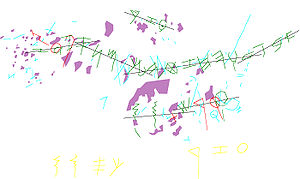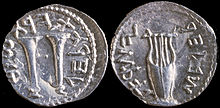- Paleo-Hebrew alphabet
-
Paleo-Hebrew alphabet 
Type Abjad Languages Hebrew, Yiddish Time period 10th century BCE – 135 CE Unicode range U+10900–U+1091F Note: This page may contain IPA phonetic symbols. History of the alphabet Proto-Sinaitic script? 19 c. BCE
- Ugaritic 15 c. BCE
- Proto-Canaanite 14 c. BCE
- Phoenician 12 c. BCE
- Greek 8 c. BCE
- Aramaic 8 c. BCE
- Kharoṣṭhī 6 c. BCE
- Brāhmī & Indic 6 c. BCE
- Hebrew 3 c. BCE
- Thaana 4 c. BCE
- Pahlavi 3 c. BCE
- Avestan 4 c. CE
- Palmyrene 2 c. BCE
- Syriac 2 c. BCE
- Sogdian 2 c. BCE
- Orkhon (Old Turkic) 6 c. CE
- Old Hungarian c. 650
- Old Uyghur
- Mongolian 1204
- Orkhon (Old Turkic) 6 c. CE
- Nabataean 2 c. BCE
- Arabic 4 c. CE
- Sogdian 2 c. BCE
- Mandaic 2 c. CE
- Paleohispanic 7 c. BCE
- Paleo-Hebrew 10 c. BCE
- Samaritan 6 c. BCE
- Phoenician 12 c. BCE
- Epigraphic South Arabian 9 c. BCE
- Ge’ez 5–6 c. BCE
Meroitic 3 c. BCEOgham 4 c. CEHangul 1443Zhuyin (Bopomofo) 1913The Paleo-Hebrew alphabet (Hebrew: הכתב העברי הקדום) (Yiddish: כתב עברי), is an abjad offshoot of the ancient Semitic alphabet, identical to the Phoenician alphabet. At the very least it dates to the 10th century BCE. It was used as the main vehicle for writing the Hebrew language by the Israelites, both Jews and Samaritans.
It began to fall out of use by the Jews in the 5th century BCE when they adopted the Aramaic alphabet as their writing system for Hebrew, from which the present Jewish "square-script" Hebrew alphabet descends. The Samaritans, who now number less than one thousand people, continue to use a derivative of the Old Hebrew alphabet, known as the Samaritan alphabet.
Contents
Letters
Hebrew letter Paleo-Hebrew letter English Name א 
Aleph ב 
Beth ג 
gimel ד 
daleth ה 
hey ו 
vav ז 
zayin ח 
het ט 
tet י 
yod כ/ך 
kaph ל 
lamed מ/ם 
mem נ/ן 
nun ס 
samekh ע 
ayin פ/ף 
pe צ/ץ 
tsadik ק 
quph ר 
resh ש 
shin ת 
tav Origins
The earliest known inscription in the Paleo-Hebrew alphabet was discovered on the stone on a wall at Tel Zayit, in the Beth Guvrin Valley in the lowlands of ancient Judea. The 22 letters were carved on one side of the 38 lb stone (17 kg) - which resembles a bowl on the other. Next would be the Gezer calendar dated to the late 10th century BCE. The script of the Gezer calendar bears strong resemblance to the akin contemporaneous Phoenician inscriptions from Byblos. Clear Hebrew features are visible in the scripts of the Moabite inscriptions of the Mesha Stele. The 8th-century Hebrew inscriptions exhibit many specific and exclusive traits, leading modern scholars to conclude that already in the 10th century BCE the Paleo-Hebrew alphabet was used by wide scribal circles. Even though very few 10th-century Hebrew inscriptions have been found, the quantity of the epigraphic material from the 8th century onward shows the gradual spread of literacy among the people of the Kingdom of Israel and the Kingdom of Judah.
In 1855 a Phoenician inscription in twenty-two lines was found among the ruins of Sidon. Each line contained about forty or fifty characters. A facsimile copy of the writing was published in United States Magazine in July 1855. The inscription was on the lid of a large stone sarcophagus carved in fine Egyptian style. The writing was primarily a genealogical history of a king of Sidon buried in the sarcophagus. It was in the Hebrew language except for a few words.[1]
Further development
The independent Hebrew script evolved by developing numerous cursive features, the lapidary features of the Phoenician alphabet being ever less pronounced with the passage of time. The aversion of the lapidary script may indicate that the custom of erecting stelae by the kings and offering votive inscriptions to the deity was not widespread in Israel. Even the engraved inscriptions from the 8th century exhibit elements of the cursive style, such as the shading, which is a natural feature of pen-and-ink writing. Examples of such inscriptions include the Siloam inscription, numerous tomb inscriptions from Jerusalem, the Ketef Hinnom amulets, a fragmentary Hebrew inscription on an ivory which was taken as war spoils (probably from Samaria) to Nimrud, and the hundreds of 8th to 6th-century Hebrew seals from various sites. The most developed cursive script is found on the 18 Lachish ostraca, letters sent by an officer to the governor of Lachish just before the destruction of the First Temple in 586 BCE. (cf. the Mesad Hashavyahu petition for favorable judgment.)
Decline of use
After the Babylonian capture of Judea, when most of the nobles were taken into exile, the Paleo-Hebrew alphabet continued to be used by the people who remained. One example of such writings are the 6th-century BCE jar handles from Gibeon, on which the names of winegrowers are inscribed. Beginning from the 5th century BCE onward, when the Aramaic language and script became an official means of communication, the Paleo-Hebrew alphabet was preserved mainly for writing the Tanakh by a coterie of erudite scribes. Some Paleo-Hebrew fragments of the Torah were found among the Dead Sea Scrolls: manuscripts 4Q12, 6Q1: Genesis. 4Q22: Exodus. 1Q3, 2Q5, 4Q11, 4Q45, 4Q46, 6Q2: Leviticus. The vast majority of the Hasmonean coinage, as well as the coins of the First Jewish-Roman War and Bar Kokhba's revolt, bears Paleo-Hebrew legends. The Paleo-Hebrew alphabet fell completely out of use only after 135 CE.
Use of Paleo-Hebrew by Samaritans
Sometime in the last two centuries BCE the Samaritan alphabet began to diverge from the Jewish one. Unlike the Jews, the Samaritans have continued to use this script for writing both Hebrew and Aramaic texts until the present day. A comparison of the earliest Samaritan inscriptions and the medieval and modern Samaritan manuscripts clearly indicates that the Samaritan script is a static script which was used mainly as a book hand.
According to the Babylonian Talmud
The Talmudic sages did not share a uniform stance on the subject of Paleo-Hebrew. Some stated that Paleo-Hebrew was the original script used by the Israelites at the time of the Exodus,[2] while others believed that Paleo-Hebrew merely served as a stopgap in a time when the original script (The Assyrian Script) was lost[3]. According to both opinions, Ezra the Scribe (circa 500BCE) introduced, or reintroduced the Assyrian script to be used as the primary Alphabet for the Hebrew language.[4] The arguments given for both opinions are rooted in Jewish scripture and/or tradition.
A third, yet less accepted opinion[5] in the Talmud states that the script never changed altogether. It would seem that the Sage who expressed this opinion did not believe that Paleo-Hebrew ever existed, despite the strong arguments supporting it. His stance is rooted in a scriptural verse,[6] which makes reference to the shape of the letter vav. The Sage argues further that, given the commandment to copy a Torah scroll directly from another, the script could not conceivably have been modified at any point.
Current use in Sacred Name Bibles
The Paleo-Hebrew script has been recently revived for specific use in several Sacred Name Bibles: including Zikarown Say’fer, The Besorah and the Halleluyah Scriptures. These translations use it for writing the Tetragrammaton and other divine names, incorporating these name written in this script in the midst of the English text.
Unicode
The Paleo-Hebrew alphabet was unified with the Phoenician alphabet and added to the Unicode Standard in July, 2006 with the release of version 5.0.
The Unicode block for Paleo-Hebrew, called Phoenician, is U+10900–U+1091F. It is intended for the representation of text in Palaeo-Hebrew, Archaic Phoenician, Phoenician, Early Aramaic, Late Phoenician cursive, Phoenician papyri, Siloam Hebrew, Hebrew seals, Ammonite, Moabite, and Punic.
Phoenician[1]
Unicode.org chart (PDF)0 1 2 3 4 5 6 7 8 9 A B C D E F U+1090x
Wikimedia Foundation. 2010.
Look at other dictionaries:
Hebrew alphabet — Infobox Writing system name=Hebrew alphabet languages=Hebrew language Jewish language time=3rd century BCE to present type=Abjad typedesc=(sometimes used as an alphabet)Fact|date=October 2008 languages=Hebrew, Yiddish, Ladino, and Judeo Arabic… … Wikipedia
History of the Hebrew alphabet — The History of the Hebrew alphabet dates back several thousand years.HistoryAccording to contemporary scholars, the original Hebrew script developed alongside others in the region during the course of the late second and first millennia BCE; it… … Wikipedia
Hebrew language — Hebrew redirects here. For other uses, see Hebrew (disambiguation). Not to be confused with Yiddish language. Hebrew עִבְרִית … Wikipedia
Hebrew punctuation — Hebrew specific marks orthographically similar marks maqaf ־ … Wikipedia
Hebrew grammar — is the grammar of the Hebrew language Contents 1 History of studies in Hebrew grammar 2 Eras 3 See also 4 References … Wikipedia
ALPHABET, HEBREW — The origin of alphabetic script has always been a subject of human curiosity. According to Greek mythology, script was brought to Greece from Phoenicia. This tradition was accepted by the Greek and Roman writers, some of whom developed it even… … Encyclopedia of Judaism
Hebrew Bible — The term Hebrew Bible is a generic reference to those books of the Bible originally written in Biblical Hebrew (and the related Biblical Aramaic). The term closely corresponds to contents of the Jewish Tanakh and the Protestant Old Testament, see … Wikipedia
Hebrew numerals — Numeral systems by culture Hindu Arabic numerals Western Arabic (Hindu numerals) Eastern Arabic Indian family Tamil Burmese Khmer Lao Mongolian Thai East Asian numerals Chinese Japanese Suzhou Korean Vietnamese … Wikipedia
Hebrew name — Part of a series on … Wikipedia
Hebrew literature — Jewish culture Visual Arts Visual Arts list … Wikipedia


